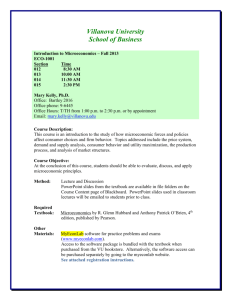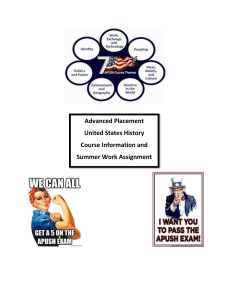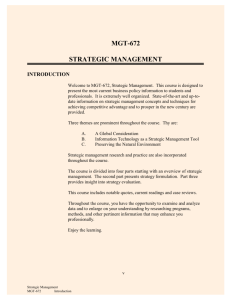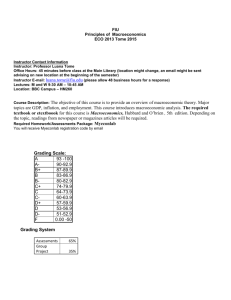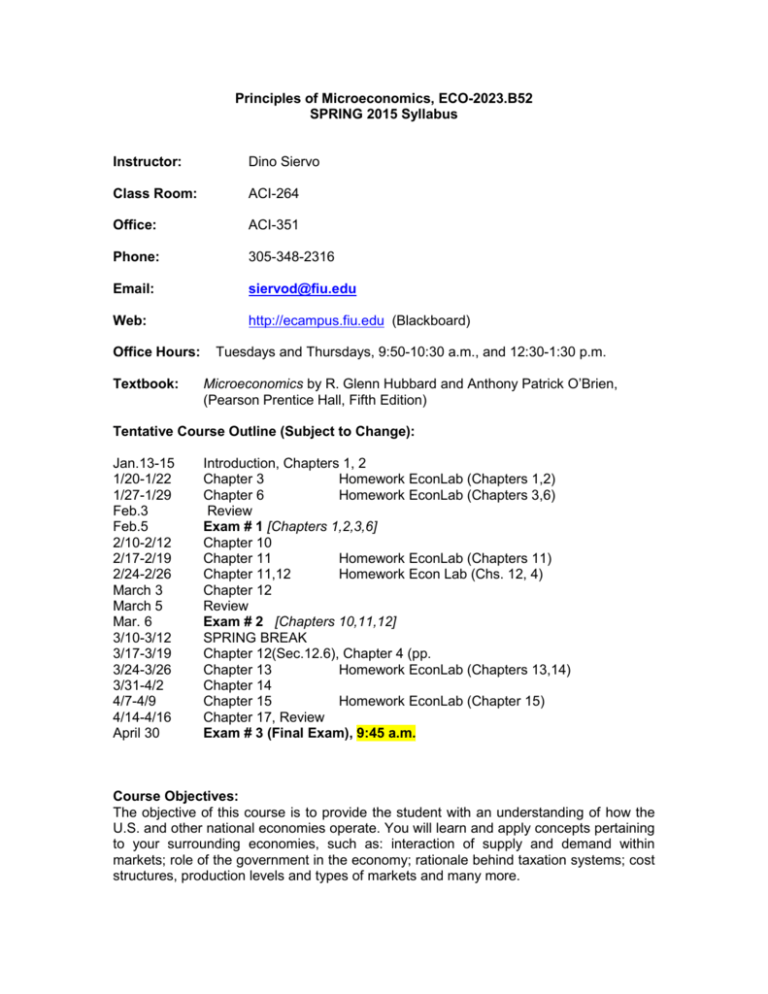
Principles of Microeconomics, ECO-2023.B52
SPRING 2015 Syllabus
Instructor:
Dino Siervo
Class Room:
ACI-264
Office:
ACI-351
Phone:
305-348-2316
Email:
siervod@fiu.edu
Web:
http://ecampus.fiu.edu (Blackboard)
Office Hours:
Textbook:
Tuesdays and Thursdays, 9:50-10:30 a.m., and 12:30-1:30 p.m.
Microeconomics by R. Glenn Hubbard and Anthony Patrick O’Brien,
(Pearson Prentice Hall, Fifth Edition)
Tentative Course Outline (Subject to Change):
Jan.13-15
1/20-1/22
1/27-1/29
Feb.3
Feb.5
2/10-2/12
2/17-2/19
2/24-2/26
March 3
March 5
Mar. 6
3/10-3/12
3/17-3/19
3/24-3/26
3/31-4/2
4/7-4/9
4/14-4/16
April 30
Introduction, Chapters 1, 2
Chapter 3
Homework EconLab (Chapters 1,2)
Chapter 6
Homework EconLab (Chapters 3,6)
Review
Exam # 1 [Chapters 1,2,3,6]
Chapter 10
Chapter 11
Homework EconLab (Chapters 11)
Chapter 11,12
Homework Econ Lab (Chs. 12, 4)
Chapter 12
Review
Exam # 2 [Chapters 10,11,12]
SPRING BREAK
Chapter 12(Sec.12.6), Chapter 4 (pp.
Chapter 13
Homework EconLab (Chapters 13,14)
Chapter 14
Chapter 15
Homework EconLab (Chapter 15)
Chapter 17, Review
Exam # 3 (Final Exam), 9:45 a.m.
Course Objectives:
The objective of this course is to provide the student with an understanding of how the
U.S. and other national economies operate. You will learn and apply concepts pertaining
to your surrounding economies, such as: interaction of supply and demand within
markets; role of the government in the economy; rationale behind taxation systems; cost
structures, production levels and types of markets and many more.
General Education Outcomes:
Economics is the study of the allocation of scarce resources among competing uses,
either through conscious public policy or through market forces The course will help
students familiarize with the use of quantitative analytical skills to evaluate and process
statistical/economic data. This will be useful in evaluating alternative methods of
achieving society’s goals and objectives. As a corollary, they will be able to
communicate more effectively in topics related to economic and business issues. The
course will also offer economic decisions and growth perspectives from the United States
and other world economies. This will provide students with knowledge on other countries and
their culture in formulating strategies and policies.
Course Study Modality:
In addition to class lectures, students are strongly encouraged to work through
MyEconLab, an online suite of tools that provides problem solving for students. Specific
homework tasks will be assigned throughout the course, including practice quizzes
under MyEconLab.
Students also have the course problems and exercises at the end of each chapter in the
textbook. Students can access solutions to end-of-chapter problems in the Study Plan
section of MyEconLab. This interactive study guide also provides additional resources
such as PowerPoint slides and Notetaker files, and eText online.
Information on options of how you can purchase your textbook package for this course
can be viewed at www.myPearsonstore.com. The bookstore will carry the student value
edition plus MyEconLab access card package, at a lower price than the textbook edition.
Bonus Points:
A two page paper analyzing microeconomics concepts learned from course material and
current microeconomic issues in news/articles from selected newspapers (Wall Street
Journal, Financial Times) or magazines (The Economist, Business Week, and others).
Papers can be submitted at any time during the semester up to the last day of class.
The paper can provide you up to 5 points to your final grade. Papers will be accepted
during class time only. None will be accepted during office hours. Also, attendance and
homework completion will add 2 points to your final grade. Class participation will be
used to determine borderline grades.
Examinations and Grading Policy:
Examinations must be taken in the assigned dates. There will be no make-up exams
except under extreme circumstances, an emergency which must be reported on or
before the exam date. The weight of grading will be calculated as 33 percent for each
exam including the final. If you have a good reason for missing Exams 1 or 2, please
contact me. In that case, your grade point weight will be based on one exam and the
final, or 50 percent each. If you miss the Final exam you will get a zero and your grade
will be computed on the basis of Exams 1 and 2, for a total grade weight of only 66
percent. Your grade is decided using the FIU distribution according to your cumulative
final points in the course: 93-100 A; 90-92 A-;87-89 B+;83-86 B;80-82 B-;77-79 C+;7376 C;70-72 C-;67-69 D+;63-66 D;60-62D-.
2
Classroom Etiquette:
Please refrain from bringing food or drinks into the classroom. Please turn off cellular
phones, iPhones, iPads. You are expected to arrive to class on time, leave when class
has concluded, and treat others respectfully by not talking during class sessions.
Important Dates:
January 20...…………… Last day to drop with full refund
March 9-14.. .….………. Spring Break
March 23...……………… Last day to drop a course with a DR grade
April 17…… … ……… Last day of class
April 30….. .. …… ….. Final Exam, 9:45 a.m., same room
3

